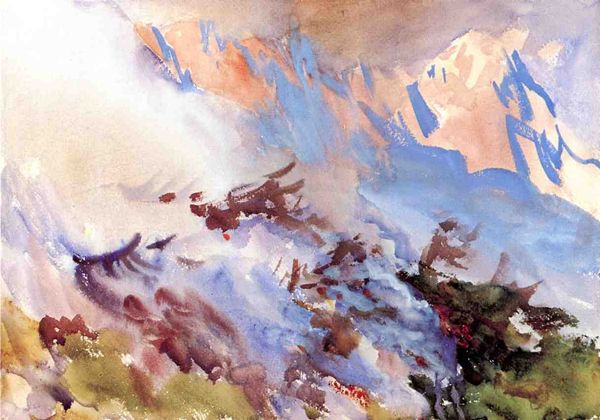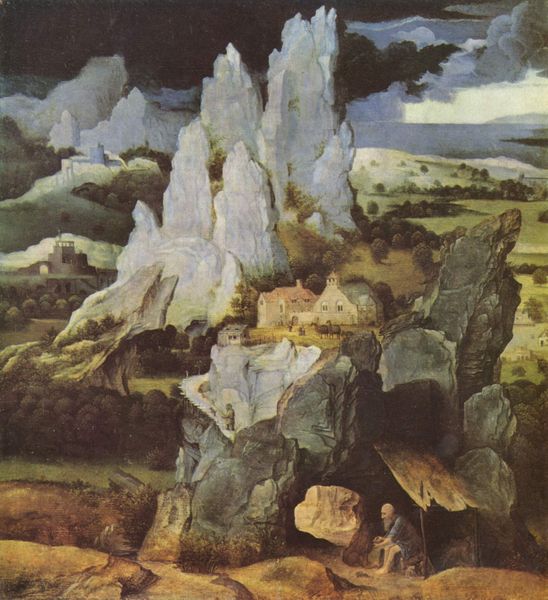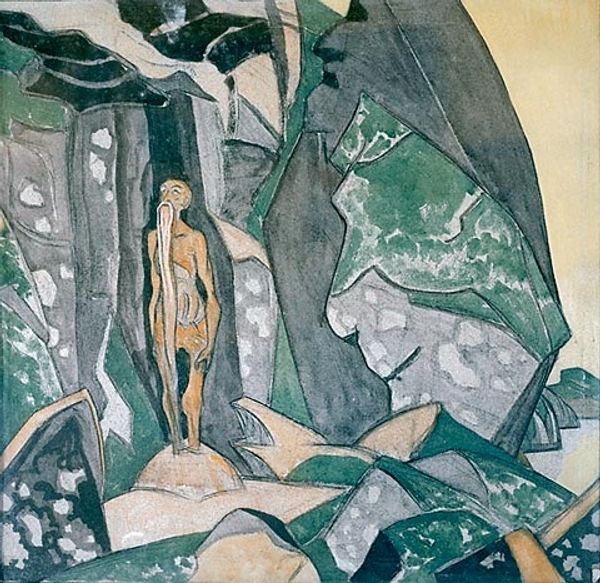
Dimensions: 35.88 x 52.39 cm
Copyright: Public domain
Curator: Welcome. Today, we are exploring John Singer Sargent's "In the Simplon Pass", a watercolor painting from 1910. It's a striking landscape held in the collection of the Brooklyn Museum. Editor: My initial impression is one of fleeting light, almost aggressively so. The sketch-like quality suggests a moment captured, not constructed, and somehow tinged with the precarity that the wealthy felt at the dawn of modernity, perhaps suggesting their fragility? Curator: The swiftness you identify is indeed key. Note how Sargent uses loose washes and dry brushstrokes to evoke the vastness and light of the Swiss Alps. The materiality here - watercolor on paper - underscores its ephemerality, contrasting with the monumental subject. Editor: It's interesting that you immediately go to the sublime natural world! For me, the female figure, placed centrally with her back turned to the viewer, complicates a straightforward reading of landscape. Who is she, and why is she positioned as both part of, and apart from, this scene? Perhaps representing the women silenced by such travel at the turn of the century? Curator: She anchors the composition. See how the verticality of her form is echoed in the distant architecture on the hillside, creating a visual rhyme? Her presence serves the formal elements of this study in color and tonality, guiding our eye. It transcends historical context by being deeply, utterly a study in compositional strength. Editor: But even her hat speaks volumes—a signifier of bourgeois identity inserted into a landscape indifferent to social distinctions. Are we to believe she has equal agency in this landscape, which for so long only white males dominated both the documentation and exploration of? She invites interrogation as to who belongs in this scene and whose presence risks erasure! Curator: You focus on narratives extrinsic to the artwork. Instead, consider the internal relations. The creamy whites and pale blues echo and enhance the play of light and shadow across the architecture. And as our eye roves over those colors, we sense a spatial dynamism which elevates this painting far beyond its social connotations. Editor: But can we really separate form from the context that brought it into being? The choices an artist makes about composition are, at some level, also about the messages they choose to subtly communicate or suppress, even if unintentionally, so how are we supposed to divorce them? Curator: Perhaps both angles illuminate its brilliance, ultimately. A successful piece provokes questions, formal and social. Editor: Agreed. Perhaps now visitors might also ask more and push a little harder about which questions they engage most keenly.
Comments
No comments
Be the first to comment and join the conversation on the ultimate creative platform.













